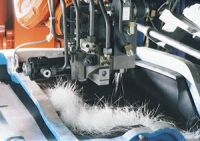 Krauss-Maffei Kunststofftechnik, Germany, has adapted its long fibre injection (LFI) process so that natural fibre reinforcements such as flax, hemp or sisal can processed into polyurethane mouldings.
Krauss-Maffei Kunststofftechnik, Germany, has adapted its long fibre injection (LFI) process so that natural fibre reinforcements such as flax, hemp or sisal can processed into polyurethane mouldings.
Natural fibre reinforced component polyurethane parts offer characteristics which are claimed to compare favourably with those of their glass-fibre counterparts. NFI Technology has been developed by Krauss-Maffei so that flax, hemp or sisal can now also be used for reinforcement.
With Krauss-Maffei’s LFI-process – presently employed in the moulding of instrument panel substrates for the BMW 5 and 7 Series, as well as the Mercedes SL ranges, for instance – the polyurethane-raw-material / glass-fibre blend is produced right inside the mixing head.
Direct wetting of individual fibres also ensures optimum adhesion of the polyurethane-matrix to the reinforcing material. Within the article being produced, volume and/or length of fibres can also be varied and adjusted to suit requirements – e.g. for extra reinforcement of mechanically particularly stressed sections of the moulding.
These characteristics can now also be used for the production of mouldings reinforced with natural fibre. Compared to glass fibre-reinforced plastics component parts, those reinforced with the lighter natural fibres can also mean weight-savings of about 15%, according to Krauss-Maffei.
The centre-piece of Krauss-Maffei’s NFI-process is the completely re-developed, purpose-designed cutting unit for natural fibres. Contrary to glass, natural fibres cannot snap in the same way. With the NFI-cutter, cutting natural fibre to length (at 5, 10, 15 and 20 millimetres) is carried out by the specially developed arrangement of two intermeshing gear wheels that also move the roving along. The NFI-mixing head itself operates to the well-proven high-pressure impingement principle: Once the PUR-components have been blended, the fibres – supported by compressed air – are conveyed into the centre of the PUR-stream. The air thus introduced expands and ensures particularly finely atomised and effective wetting of the natural fibres, which are poured into the open mould simultaneously with the PUR-blend. For the more effective covering of surfaces, the processing unit’s jet stream can also be made to oscillate.
The PUR-output rate of the present Krauss-Maffei LFI/NFI-mixing heads lies at around 80 to 300 g/s (LFI/NFI-22/28-MK8), or 250 to 500 g/s (LFI/NFI-30/36-MK12); the natural fibre content can rise as high as about 40%. Output rates of natural fibre at the present state of development are at around 80 g/s – subject to the tensile strength of the natural material. At a characteristic component part weight of 4,000 grams, the typical NFI pouring time takes about 20 s (cycle time per mould: two to four minutes). Tensile strengths achievable with the natural fibre structure, elastic modulus and notched impact strength in three- to four- millimetre thick component parts (density range from 700 to 1,100 kg/m3) are within an order of magnitude 32 to 38 N/mm2, (tensile strength), 3,000 to 4,500 N/mm2 (elastic modulus) and 10 to 30 kJ/m2 (impact strength). Transition from LFI to NFI is possible with existing equipment, due to the modular design used by Krauss-Maffei.
(Vgl. Meldung vom 2004-03-15.)
Source
netcomposites.com vom 2004-03-29.
Share
Renewable Carbon News – Daily Newsletter
Subscribe to our daily email newsletter – the world's leading newsletter on renewable materials and chemicals









